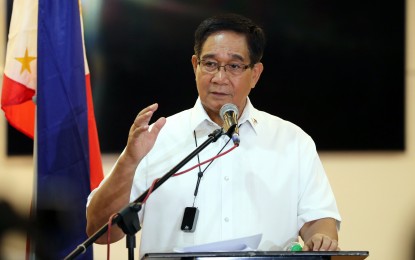
National Security Adviser (NSA) Hermogenes Esperon, Jr. (PNA File photo)
MANILA – National Security Adviser (NSA) Hermogenes Esperon, Jr., on Friday said the inclusion of Davao City barangays in the proposed Barangay Development Program (BDP) is vital because of their proximity to five communist guerrilla fronts.
Secretary Esperon was referring to reports that around 79 of the city's barangays would benefit from the BDP that seeks to provide PHP20 million worth of development funds for each village cleared of the communist insurgency threat but still vulnerable to the recruitment by the Communist Party of the Philippines-New People's Army (CPP-NPA)
The BDP, which has a proposed budget of PHP16.4 billion for 2021 that will benefit 800 barangays nationwide, is under the auspices of the National Task Force to End Local Communist Armed Conflict (NTF ELCAC) wherein Esperon is also vice-chairperson.
5 guerilla fronts
"It is worth noting that, according to the Armed Forces of the Philippines (AFP), the Davao area accounted for an appreciable number of cleared barangays from the period of 2016-2019. Security forces estimate that Davao City is within the vicinity of five guerilla fronts, with one guerilla front inside its jurisdiction," said Esperon, who is also National Security Council Director General, in a statement forwarded to the Philippine News Agency Friday.
He added that the inclusion also stems from the fact that the Eastern Mindanao Command (EastMinCom), the AFP unit tasked to secure the region, is confronting 17 guerilla fronts, which is the highest among all of the unified commands.
"Particular to Davao City is the need for school buildings to replace the Salugpungan schools illegally operating in the area. In 2019, more than 55 Salugpungan schools were illegally operating and recruiting Indigenous children into armed conflict," Esperon said.
In Davao City alone, several Salugpungan schools have been identified, with the Department of Education (DepED) planning to set up legitimate schools to replace those in nearby areas.
"Data from security forces indicate that Davao region is a recruitment and training ground for the NPA," Esperon added.
He added that there are 11 ethnic tribes of indigenous peoples in Davao City alone whose children are vulnerable to recruitment.
"In fact, eight out of ten NPAs in Eastern Mindanao have been recruited from Indigenous Peoples (communities)," Esperon said.
Davao City, he said, comprises an extensive area and a substantial population.
"Initially, the Regional Task Force XI of the National Task Force to End Local Communist Armed Conflict (RTF-ELCAC) had included geographically-isolated and disadvantaged areas of Magtuod, Tapak, Colosas, Salapawan, Lumiad, Mapula, Panalum, Mabuhay, Tibuloy, Salaysay, Malamba, Guitan, Biao Joaquin, Talandang and Dominga, totaling to 15 communities," Esperon said.
The Regional Task Force, however, had recommended the inclusion of several other barangays in consideration of local issues of conflicts, and specific areas identified by former rebels thus, the increase in the total number of identified barangays in Davao City for the BDP.
Mindanao’s economic hub
"Clearly, the facts show that Davao City can be considered a province by itself. Davao City is the hub of the economy in Mindanao, with a Gross Regional Domestic Product (GRDP) rate of 9.4 percent and 40,499 businesses established within the city, and a population of 1,673,832 people as of 2018," Esperon said.
He added that the city is likewise home to three consular offices and six honorary consular offices of our diplomatic partners in Mindanao.
"The profile of Davao City indicates that it is an essential area for regional growth. For a City nearly as large as the surrounding provinces of Davao City, it is able to generate substantial economic activity and progress not just for the region but for the entire Mindanao," he said.
Peace and stability
Also, the abundance of culture, people, and wealth makes it an attractive resource for the NPA, particularly in terms of ease of logistics for the insurgents.
"Hence, the overall progress in Mindanao points to the fact that we cannot forgo the stability, peace, and order now prevailing in Davao City. Should Davao City succumb to the NPA, so goes the rest of Mindanao," he added.
Taking into consideration the population, landmass, economy, and strategic significance of Davao City, Esperon said the city is the lynchpin of peace and stability for all of Mindanao.
He added that factors serve as justification for the added emphasis of the BDPs implementation in Davao City and its surrounding areas.
"We at the NTF-ELCAC stand behind the thorough vetting process and the parameters of the BDP. It is our intent that the causes of insurgency in these areas will be addressed through the timely implementation of the BDP," he said.
Barangays selected for the BDP, he added, had already gone through validation from various national government agencies, in partnership with the AFP.
"Their regional counterparts have verified that these are indeed areas vulnerable to the threat and influence of the NPA," he said, adding that local chief executives, as well as the regional operating units of the national government, have determined a total number of priority areas for the BDP.
The BDP consists of a package of development programs that aim to alleviate the conditions of priority barangays.
Projects earmarked for each barangay are as follows: PHP12 million for farm-to-market roads (Department of Agriculture-Department of Public Works and Highways); PHP3 million for school buildings (DepEd); PHP2 million for water and sanitation systems (Department of Interior and Local Government); PHP1.5 million for national greening/forest protection (Department of Environment and Natural Resources); and PHP1.5 million for health stations (Department of Health).
The AFP and local operating units of national government agencies have validated the need for development programs, he added.
"The NTF ELCAC intends to ensure that the projects in these priority areas are sustainable. Thus, to prevent the NPA from exploiting these communities, communities threatened by the influence of the armed rebels were included in the final list of priority areas," Esperon said. (PNA)
